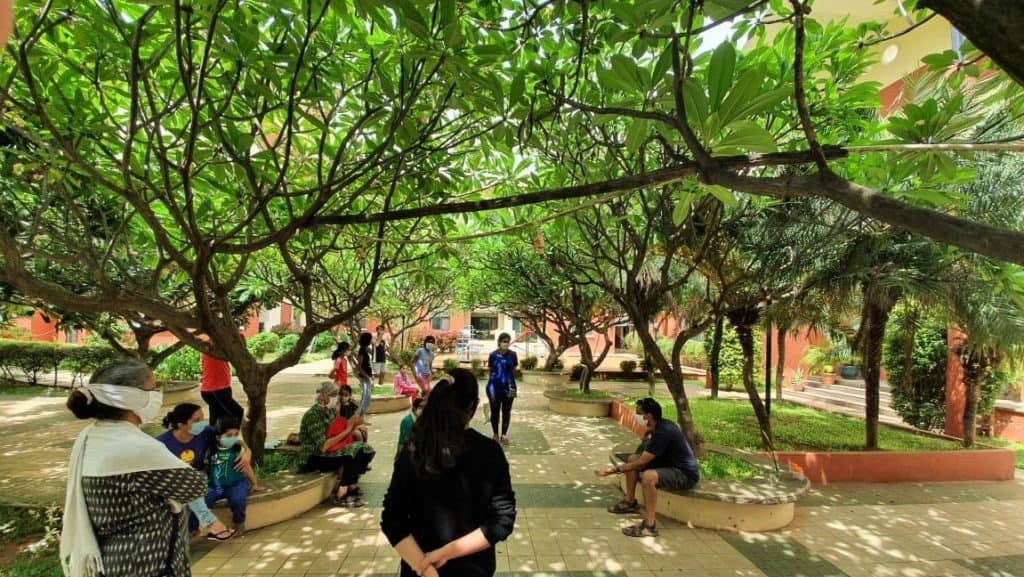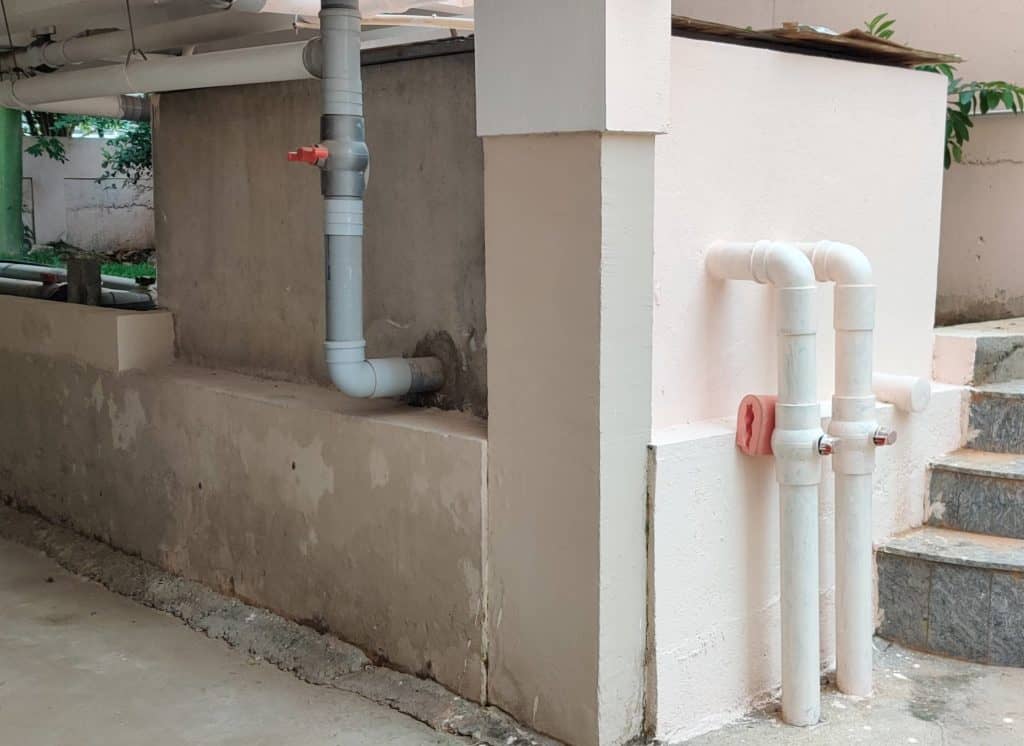Bengaluru’s pristine environment of the 60s and 70s has, in the past half a century, deteriorated significantly. People who have lived here for the past few decades would have a clear perception of this environmental degradation.
Left to itself, the environment in the city’s gated communities too would be much the same as that exists on the outside. When it comes to air pollution, gated communities experience the same pollution as other city residents.
Although every individual living in Bengaluru has the duty to work towards reducing pollution, let us look at initiatives gated communities can consciously take, to reduce air pollution and improve the environment!
The current environment in Bengaluru can be analysed in four critical categories: air, water, soil and aesthetics
Air
Among others, industries, power plants and automobiles have been belching out Carbon dioxide (CO2), Sulphur oxides (SOx), Nitrogen oxides (NOx), Carbon monoxide (CO), Volatile Organic Compounds (VOC), Particulate Matter (PM), Persistent Free Radicals, Chlorofluorocarbons (CFCs), Ammonia, Odours and other pollutants, pushing up levels of greenhouse gases, other unhealthy gases and particulate matter in the atmosphere to alarming levels.
The current level of oxygen in our atmosphere is about 21%, adequate to sustain life. As oxygen reacts chemically with almost anything, a significant increase in the level of oxygen in the atmosphere in the immediate future is not practical. However, the fact that the current level is steady at 21% indicates that there is constant production of Oxygen – the chief source being photosynthesis in plants, whereby carbon dioxide is absorbed by them, releasing oxygen into the atmosphere.
While dust, dirt, soot, smoke, etc. are easily seen by the human eye, there are Particulate Matters (PM) of size 2.5 micrometres or below (PM2.5), causing particle pollution. PM2.5 concentration in Bengaluru is currently 1.7 times the annual air quality guideline value provided by WHO. Whereas WHO considers an Air Quality Index (AQI) of up to 50 as good, in many locations in Bengaluru it exceeds 200 many times during the year. WHO has declared AQI of 200 to 300 is unhealthy for humans.
In landfills located around Bengaluru, one can smell the obnoxious odour of perishing organic matter. Methane is a by-product of the anaerobic respiration of bacteria thriving in landfills with high amounts of moisture. At maximum anaerobic decomposition, the methane concentration can reach up to 50% of the composition of landfill gas, exposing humans to the risk of explosion/combustion.

Read more: Bengaluru’s climate no longer cool. Here’s why
Water
Industries and homes have been spewing out dyes, chemicals, sewage and other pollutants into water bodies and waterways, polluting not only the water but also the groundwater itself – which now contains unacceptable levels of Nitrogen, Phosphorous, Potassium, etc. and at times even heavy metals in some locations.
Bengaluru is receiving an LPA rainfall of 986.1 mm. This quantum of rainfall over Bengaluru is more than adequate for its entire population, @135 litre per capita per day (lpcd) specified by WHO, for the entire year. Yet, Bengaluru’s citizens do not have enough water. There are locations in Greater Bengaluru, where one needs to dig well below 1,800 ft to strike water.
Soil
Chemicals polluting the water have also been polluting the soil as well. Adding to the soil pollution is the use of chemical fertilisers and pesticides. This adversely impacts the mini and micro life in the soil, which include microbes like viruses, bacteria, fungi, protists, invertebrates such as earthworms and nematodes, plant roots and even small mammals living in burrows. When life below ground is impacted adversely, food production could be impacted too.
Aesthetics
Haphazardly discarded waste and landfills have a negative impact on the aesthetics around us, accentuated by unkempt surroundings in some places.
The contest
With the intention of encouraging gated communities to pursue such positive measures, the Bangalore Apartments’ Federation (BAF) with a membership of over 1100 apartment/ layouts/villa complexes in its fold, has launched the ‘BAF Hasiru Apartment Contest’.
All member complexes of BAF, as well as non-member complexes in Greater Bengaluru, are invited to participate. Those who have implemented sustainable practices impacting the environment positively in the past would be evaluated by an appropriately Weighted Evaluation System and awarded in a glittering ceremony at Bangalore International Centre, at 4 PM on Aug 20, 2022.
The contest closes on Sun, Jul 17, 2022 – you can participate by clicking https://bit.ly/baf-hac! The list of questions for which some preparatory effort could be needed has been broadcast in all the BAF ‘Whatsapp’ and ‘Telegram’ fora – once these responses are gathered, entering the data in the google form of the contest needs only 10 or 15 minutes! Hurry and participate – rewards are awaiting your participation.
How all these pollutants impact our environment is not very difficult to comprehend. And while gated communities are not in a commanding position to wield any great influence on citywide metrics, they certainly can implement a number of carefully designed sustainable practices, to impact their own environment positively. If all the gated communities take such initiatives, the environment of the city as a whole too would be impacted positively.
With the intention therefore of spreading a positive message among those living in the city’s gated communities, let us take a look at the implementable measures highlighted below!

Air management
While not much can be done by gated communities at reducing the generation of these pollutants, they certainly can implement a few measures that could bring about some reduction:
- Install rooftop Solar Generation Plants, so as to generate as much renewable energy as practical for the consumption of the community. In addition, as the power drawn from the utility vendor gets reduced, the community can save a significant quantum of money.
- Make use of Electric Vehicles (EV) in preference to fossil fuel vehicles, to significantly reduce vehicle emissions. Installation of EV Chargers in the complexes can facilitate this transition.
- Make use of LED Lamps, in place of GLS/CFL /standard tube lamps, to reduce energy consumption.
- Grow a number of trees around the complex to filter out PM from the air.
- Grow a number of trees, plants and bushes in the premises to reduce the carbon footprint in the complex.
Water Management
Several mitigating measures can be implemented by gated communities to reduce their need to obtain water from external sources/bore wells. This will result in significant savings in cost.
- Harvest the rainfall on the roof, filter and use for regular requirements in homes.
- Harvest the entire runoff for groundwater recharge When correctly done, the level of water table in the complex would rise and clean, potable soft water can be drawn from even open wells.
- Use the treated water obtained from the STP for flushing toilets, gardening and car washing!
- Economise and reduce consumption of water by use of Aerators, reuse of RO reject, etc!
- Metre the water supplied to each unit in the complex and bill on a slab rate basis, to promote frugal use resulting in a significant reduction in the total quantum of water needed.
- Plant a lot of trees and plants around – the roots of trees and plants retain water in the soil, conserving and protecting the available water!
- Install drip irrigation and sprinkler systems for watering the garden – this will not only reduce the consumption of water but also result in reduction of resources required to manage it!

Read more: Six reasons why Bengaluru apartments are not reusing their wastewater
Soil Management
Treating household and other waste properly in order to obtain useful products from it is a sustainable practice. It also simultaneously ensures that waste doesn’t pollute our environment!
- Minimise waste generation. And ensure daily waste clearance.
- Segregate waste, so as to ensure that each type is treated appropriately and the adverse impact of the different types of waste on the environment is minimised – wet (Kitchen) waste, garden waste, dry recyclable waste, Landfill, e-waste, medical waste, etc.
- While the different types of waste need to be disposed off appropriately through channels authorised to handle them, wet (kitchen) waste and garden waste can be composted in situ for use in the complex garden and excess thereof can be sold to farmers.
Read more: How this Bellandur apartment saves Rs 25,000 a year composting garden waste
Aesthetics Management
A clean, beautiful garden with a lot of foliage and colourful flowers improves the aesthetics of the complex. Space can be no limitation as even in small spaces, rapidly growing Miyawaki forests can be established with native trees and plants. Such gardens improve the availability of oxygen in the air around. Roots of trees and plants hold the soil together and prevent soil erosion. Honey bees being sensitive to the presence of harmful chemicals, their presence in the garden and beehives in the complex are indicators that the environment in the complex is conducive to sustainable life.
- Avoid use of chemical fertilisers in the garden, but use manure obtained from the in-house composting plant(s).
- Avoid use of chemical pesticides, but use organic pesticides – larvae of insects need not all be killed, they are part of the biodiversity around us and are food to small birds and other garden life.
- Avoid use of chemical fogging to kill mosquitoes, but ensure that there is no stagnant water in the premises/vicinity for their reproduction – mosquitoes can’t all be killed!
- Don’t spit anywhere.
Implementing these measures in gated communities can be steps in the right direction. Let each of our gated communities start implementing every sustainable practice now, step by step! Every baby step a community takes in the right direction could reduce pollution and improve our environment.